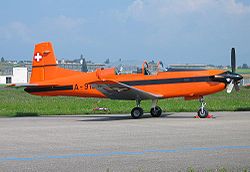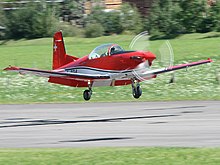Pilatus PC-7
| Pilatus PC-7 | |
|---|---|

|
|
| Type: | Trainer aircraft |
| Design country: | |
| Manufacturer: | |
| First flight: |
April 12, 1966 |
| Commissioning: |
1978 |
| Production time: |
1977 – today |
| Number of pieces: |
520 |
The Pilatus PC-7 is a two-seat propeller-turbine-powered trainer aircraft . It was derived from the Pilatus P-3 . In contrast to the P-3, it is powered by a propeller turbine, has a revised airframe, a new canopy and aerodynamic improvements.
History of origin
The single-engine, multi-purpose training aircraft was originally designed with a piston engine drive as a further development of the P-3. The first flight of the PC-7 was carried out on April 12, 1966 by Rolf Böhm. Due to a lack of demand, series production did not start until 1977. Therefore, the first series delivery as a "turbo-prop trainer" did not take place until 1978. Due to the good performance and lower costs compared to jet trainers , the PC-7 then also found large sales. The qualities of the turboprop engine for pilot training in basic training, instrument flight, aerobatics and night flight, and especially tactical training, are still highly valued by pilots and instructors in the P-7 model.
design
The PC-7 is a low-wing aircraft made of light metal with a turbo-prop engine in the nose. The cockpit canopy is in two parts and offers excellent all-round visibility. The landing gear can be retracted. The PC-7 MkII is equipped with two Martin-Baker CH.Mk.15A zero-zero ejection seats.
Versions
- PC-7 "Turbo Trainer"
- Two-seat basic trainer.
- PC-7OE "Turbo Trainer"
- Two-seater basic trainer with weapon pylons for the Austrian army aviators .
- PC-7 MkII "Turbo Trainer"
- In this variant, the fuselage and avionics come from the PC-9 ; the combination with the propeller turbine of the PC-7 lowers the maintenance costs.
- NCPC-7 "Turbo Trainer"
- The existing PC-7s of the Swiss Air Force have been modernized with an IFR- compatible cockpit and new multifunction displays . The designation NCPC-7 was provisionally used in the Swiss Air Force to distinguish modernized PC-7 (NC for new cockpit) from not yet implemented. It was removed after upgrading the last of the 28 aircraft in 2009. As a result, the entire turbo trainer took on the name PC-7 again.
- S-68
- The company " HESA " from Iran produces copies with the designation S-68 through an unlicensed replica in Iran .
Armament
For weapons training, it is possible to carry 1044 kg external loads on six pylons
- Unguided air-to-surface missiles
- 4 × Forges de Zeebrugge LAU-32 rocket tube launch container for 7 × unguided Hydra air-to-ground missiles each ; Caliber 70 mm
- 4 × TBA 68-7 rocket tube launch containers for 7 × unguided air-to-surface missiles SNEB ; Caliber 68 mm
- 4 × Matra F2 rocket tube launch containers for 6 × unguided air-to-ground missiles SNEB ; Caliber 68 mm
- 4 × Abel rocket tube launch containers for 7 × unguided M75 air-to-ground missiles each; 75 mm caliber
- External container
- 2 × FN Herstal ETNA-TMP-5 machine gun containers with 2 × 7.62 mm FN MAG 58P machine guns each with 500 rounds of ammunition
- 4 × FN Herstal HMP-250-LCC machine gun containers, each with 1 × 12.7 mm FN-M3P machine gun with 250 rounds of ammunition
- 2 × drop-off additional fuel tanks with 248 liters of kerosene
- 2 × disposable additional fuel tanks with 145 liters of kerosene
Technical specifications
| Parameter | Data |
|---|---|
| crew | 2 |
| length | 9.75 m |
| span | 10.40 m |
| height | 3.21 m |
| Wing area | 16.60 m² |
| Empty weight | 1300 kg |
| Maximum flight weight without external loads |
1900 kg |
| Maximum flight weight with external loads |
2700 kg |
| Marching speed | 330 km / h |
| Top speed | 556 km / h |
| Service ceiling | 9755 m |
| Climb performance | 10 m / s |
| Accelerations | +6 g / −3 g |
| Range | 1250 km |
| Engine | Pratt & Whitney Canada PT6 A-25A2 |
| power | 650 WPS |
User states
- 25 × PC-7
- 24 × PC-7
- 7 × PC-7 (two of which are still airworthy)
- 0 × PC-7 MkII (5 ordered, delivery from 2013)
- 4 × PC-7 MkII
- 10 × PC-7
-
 France : ( Armée de l'air )
France : ( Armée de l'air )
- 5 × PC-7
- 12 × PC-7
- 75 × PC-7 MkII ordered. Delivery from 2012 (additional order of 38 PC-7 MkII)
- 35 × PC-7 (replacement by an unknown number of Hesa S-68 clones)
-
 Iraq ( Iraqi Air Force )
Iraq ( Iraqi Air Force )
- 52 × PC-7 (today mostly stored unfit to fly)
- 27 × PC-7
- 19 × PC-7 MkII (one of which was destroyed in a crash)
- 88 × PC-7
-
 Myanmar (Burma) (Myanmar Air Force)
Myanmar (Burma) (Myanmar Air Force)
- 17 × PC-7
- 2 × PC-7
- 13 × PC-7
-
 Austria : ( Austrian Air Force )
Austria : ( Austrian Air Force )
- 16 × PC-7OE
-
 Switzerland : ( Swiss Air Force )
Switzerland : ( Swiss Air Force )
- 40 × PC-7s, of which 27 are still in use as modernized PC-7s.
- 60 × PC-7 MkII
- 3 × PC-7
- 4 × PC-7 (one of the first batch destroyed in a crash. Two second-hand machines acquired in 2007.)
- 6 × PC-7s (one destroyed in a crash on February 21, 2008, two pilots dead.)
- 31 × PC-7
See also
- Aerobatic teams
- Comparable advanced trainers
- Embraer EMB-312 "Tucano"
- Embraer EMB-314 "Super Tucano"
- Enaer T-35 "Pillan"
- KAI KT-1 "Ungbi"
- Hawker-Beechcraft T-6 "Texan II"
- Socata TB 30 "Epsilon"
- PZL Warszawa PZL-130 "Orlik"
- AIDC T-CH-1 "Chung-Shing"
- HESA T-68
literature
- William Green: The planes of the world. Werner Classen Verlag, Zurich and Stuttgart 1979.
- Roland Eichenberger: Pilatus aircraft 1939–1989. Pilatus Flugzeugwerke, Stans 1989.
Web links
Individual evidence
- ↑ Pilatus PC-7 Turbo Trainer , vtg.admin.ch.
- ↑ Pilatus Receives Order for PC-7 MkII from Botswana Defense Force ( Memento of December 3, 2011 in the Internet Archive )
- ↑ Jane's Information Group : Indian MoD approves PC-7 follow-on buy ( Memento from April 2, 2015 in the Internet Archive ), accessed on March 2, 2015
- ↑ Airshow horror: RMAF pilot dies in UUM crash (Update 2) ( Memento from December 3, 2011 in the Internet Archive )

